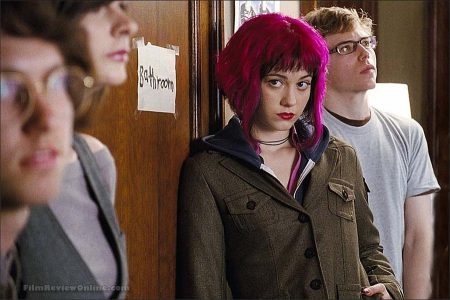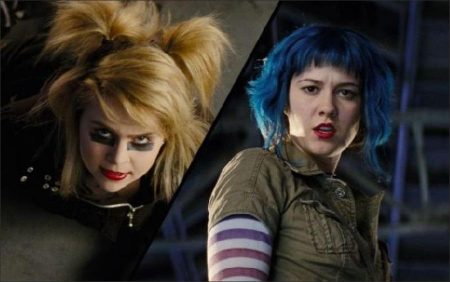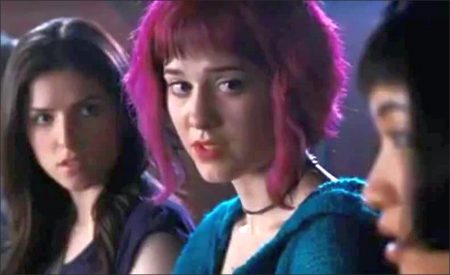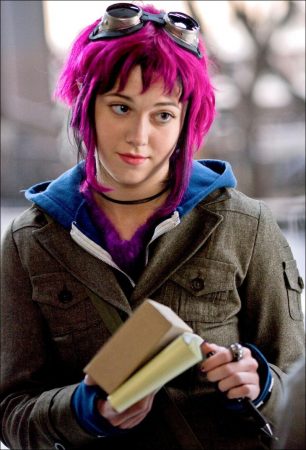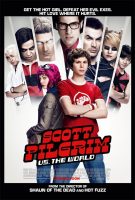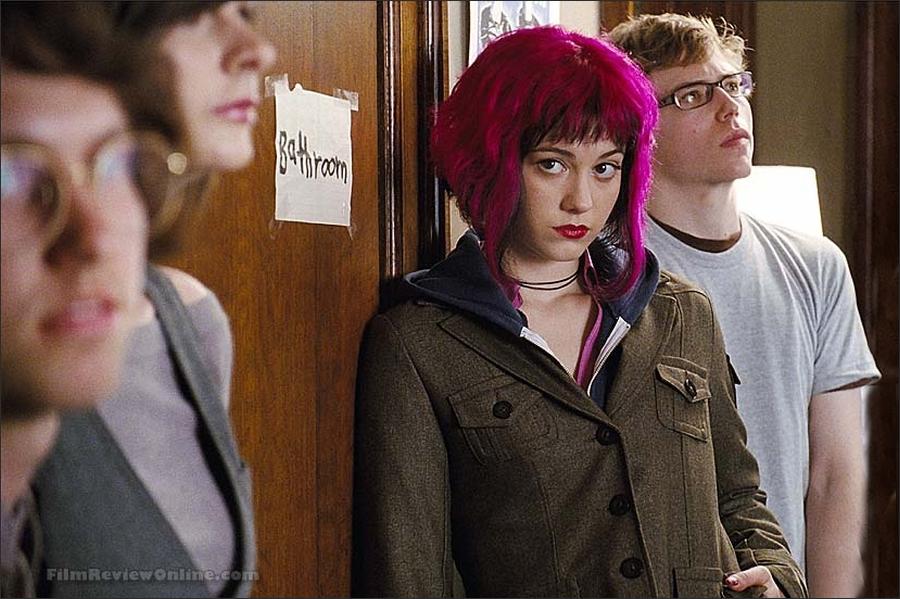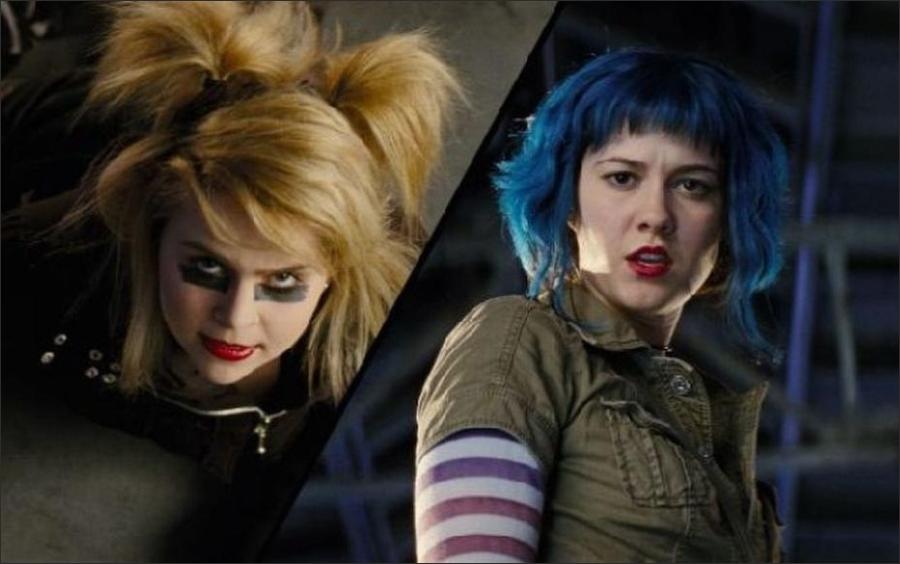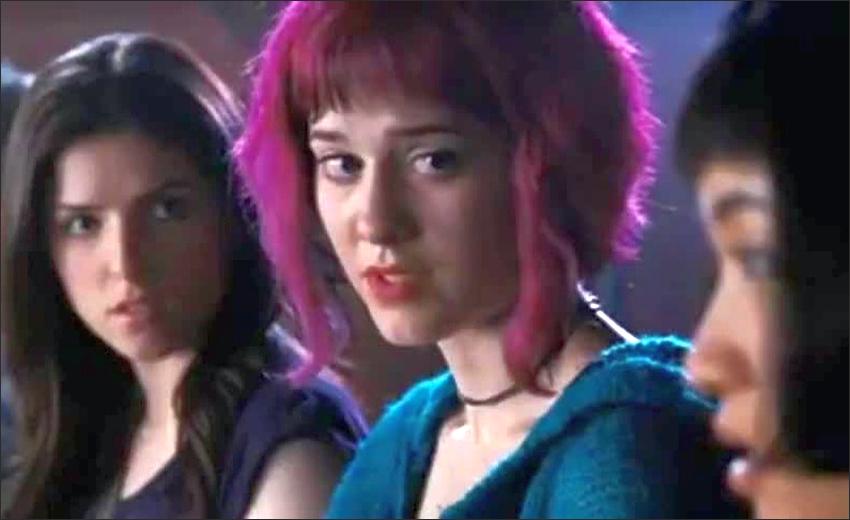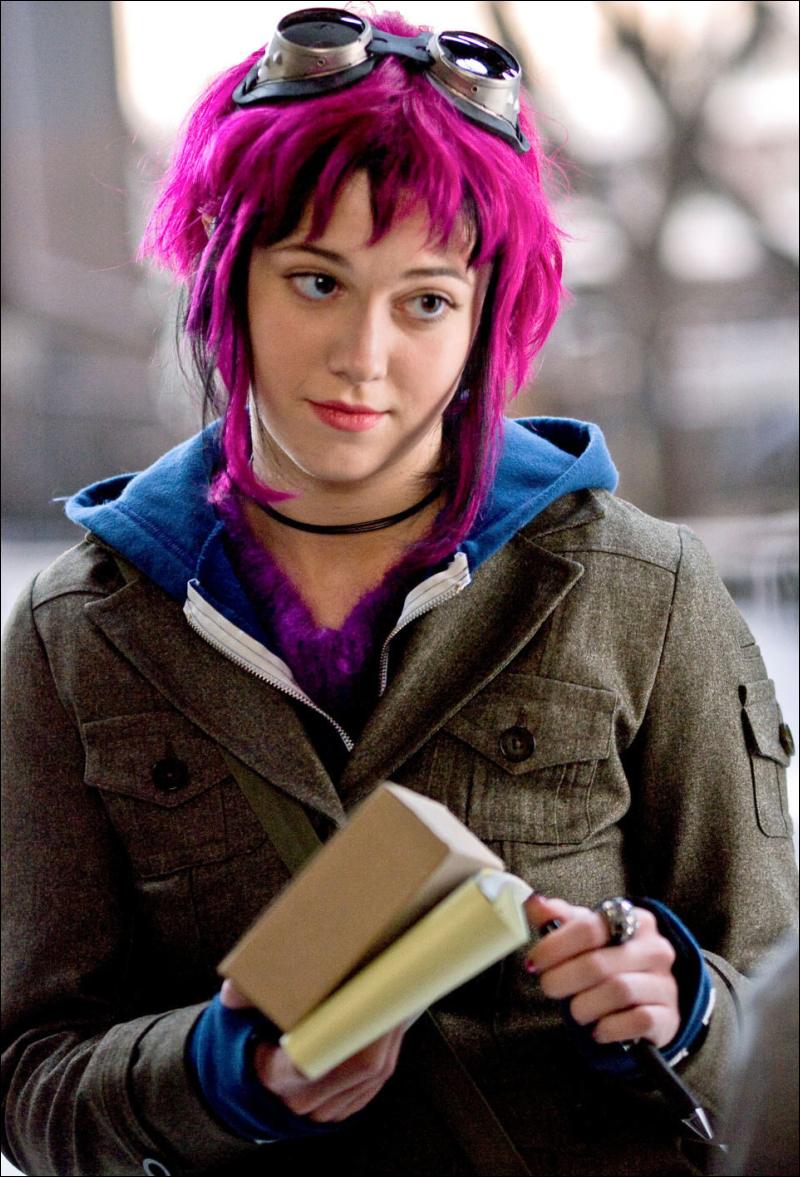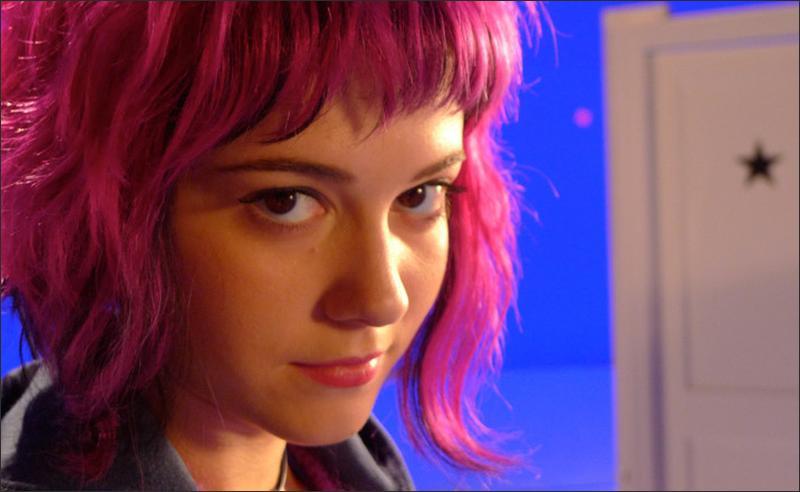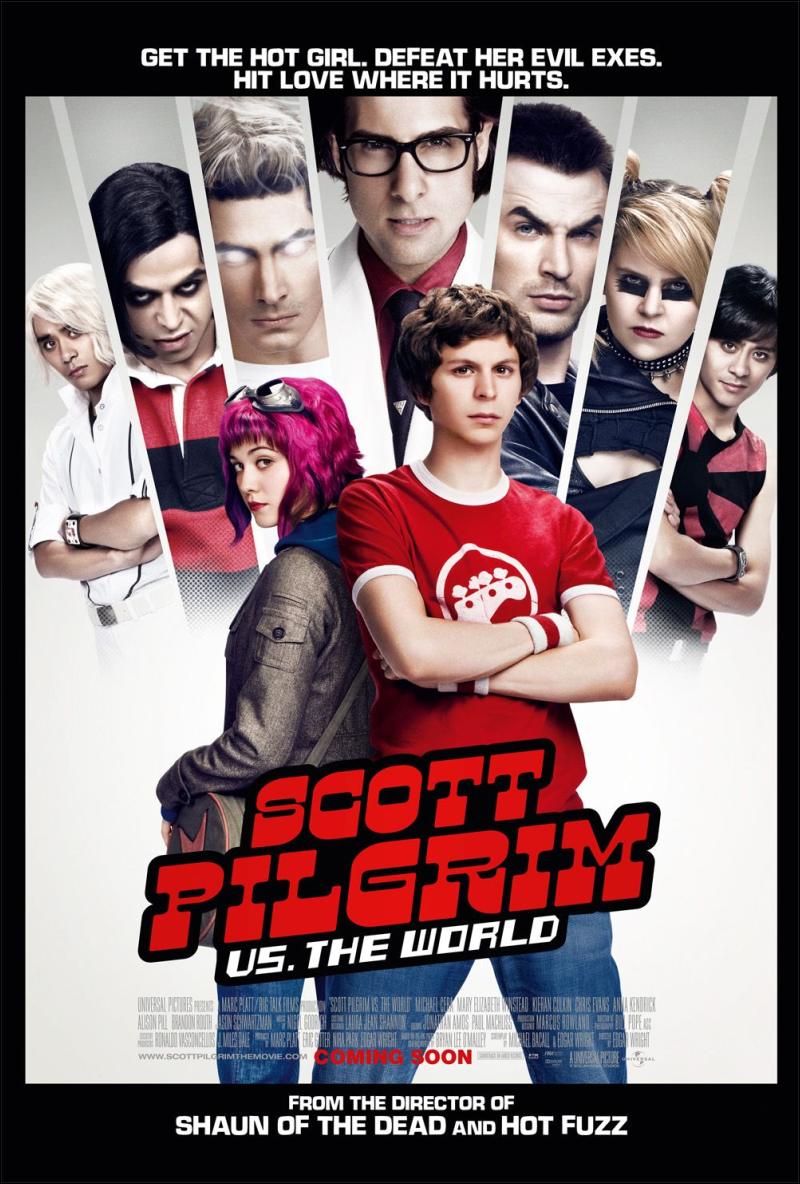Visual Effects
Instead of the typical, technical 3-D previsualization done for many films, the previz for Scott Pilgrim was created in homage to the graphic style of O’Malley’s novels, with additional animated elements inserted to round it out. During the pitching phase of the project, a black-and-white animatic was designed to give the look and feel of the first fight, the one in which Scott Pilgrim faces off against Matthew Patel.
With panels taken straight from the pages of the books, Scott Pilgrim was designed by blending a mixture of references to Japanese anime and video games from multiple eras. This allowed for a concept piece that illustrated the energy Wright wanted for his live-action. Before the project was green-lit, this animatic became the basis for a live-action test to convince the studio the film was feasible.
As the project moved into full production, U.K.-based VFX company DOUBLE NEGATIVE—with additional work from Toronto-based digital studio MR. X—created similar animatics for the remaining fight sequences, performances and other parts of the film that would benefit from bringing the comics to life. The majority of Mr. X’s work involved cleanup and simplification of practical locations, as well as adding stylized snow.
Once preproduction began, the entire film was storyboarded by Oscar Wright in the style of the novels. Wright was responsible for crafting the film’s concept art and graphics. Wherever possible, exact panels from the books were duplicated to set up shots, and then coverage was filled in to flesh them out for the film version. The visuals were always imagined by asking a simple question: Is this something that Bryan would have drawn?
Each day of shooting, the storyboards were distributed to the crew, who used the panels to compose the live-action shots. The production design and art direction were underpinned with the constant focus on graphic simplification in line with the comic artwork, which flowed through every element of the design—including sets, wardrobe and props.
Because of practical considerations, it wasn’t always possible to maintain this look through the art department alone; naturally, VFX became heavily involved… especially on location. Though the film is shot in Toronto, the teams had to extend a good deal of the location shots to achieve the hyper real look Wright wanted (e.g., as Scott and Ramona walk through snow to the swings). As it was impossible to blanket an entire street with perfect-looking snow in the middle of the summer, much of the team’s work involved simplifying the look of practical locations and dressing them in the wintry style of the film.
For the VFX crews, the hero text graphics (once animated) became a favorite part of the production. On set, the teams would overlay a simple static graphic on the video-assist so shots could be composed. Once they were rendered, it was exciting to see memorable copy from O’Malley’s novels burned across the screen.
Approximately six months before preproduction began, production designer Rowland began prescouting locations. Because O’Malley drew a fair number of his exterior panels while looking at the actual locations that inspired him (e.g., Wallace’s apartment, Wychwood Library, Goodwill, Stephen Stills’ place, Ramona’s apartment, the house in which Scott grew up and Knives’ high school), the team was fortunate enough to use the actual locales described in the books.
VFX team members accompanied Rowland and took still photographs that precisely matched the angle and composition of the panels in the books. From there, they put together a package that showed each of the locations with various levels of simplification—ranging from the photographs by themselves to looks that precisely matched O’Malley’s style.
Locations and Design
As the books are set in Toronto and because the city has the infrastructure in place to host a film the size of Scott Pilgrim vs. the World, the decision to shoot there was obvious. Many of Toronto’s haunts that are given center stage in O’Malley’s books were sure to be recognized in the film. These include Casa Loma, Honest Ed’s, Lee’s Palace, Pizza Pizza and Second Cup—places O’Malley says “are ubiquitous in Toronto. I have a soft spot for them.”
As Wright and production designer Marcus Rowland developed the look of the action-comedy, they knew they wanted to celebrate the Ontario city. It wasn’t simply bringing lines from the novels into the movie that interested them. “I wanted to represent Bryan’s artwork as much as possible, but also use the real locations that he used as reference for his books,” Wright comments. “In several key scenes, we shot the actual houses, libraries, parks and music venues that Bryan took photos of in 2003.”
Rowland adds: “We embraced all that’s great about the flavor and texture of Toronto itself. It’s known as one of the most multicultural cities in North America, and Scott Pilgrim vs. the World was shot at the real locations where Bryan drew the pictures.”
The designer explains that he used a multitude of colors to reflect the emotion of the story, down to the color of the swords that Scott and Gideon use to duel. O’Malley marvels: “Marcus did an incredible job bringing the comic universe to the screen, right down to the last detail of each character’s apartment. One of the craziest moments for me was when I walked on the set of Wallace’s apartment. It was as though it had jumped off the comic-book page.”
On stages in Toronto, Rowland created the apartments of Wallace and Scott, as well as Ramona’s one-bedroom. O’Malley adds: “They are just as I visualized them, only more real. It’s a little strange.”
For her part, Ramona Flowers felt right at home. Laughs Winstead: “It was like we were really there. All the places they’ve built, the clubs they’ve built…it doesn’t feel like we were on a set at all. I wanted to just move into my apartment. It felt so authentic.”
Music of Scott Pilgrim
Throughout the history of comics and graphic novels, musical references have been a big part of the medium. So is the case with O’Malley’s books, as Scott’s band takes on other bands in music battles. O’Malley notes: “It’s a tradition in comics, way back to ‘The Archies.’”
As he constructed the film, the director knew that the soundtrack of Scott Pilgrim vs. the World should reflect the universe in which Scott and his friends live, as well as speak to a generation that has grown up gaming. Wright offers: “I am a huge music fan, so the idea of blowing people back into their seats with the soundtrack appealed to me immensely.”
Bacall remembers when he and Wright discussed how to approach the musical performances. He states: “Edgar initially commented that most ‘live’ music in movies kind of sucks. We were coming up with gags to get around hearing the bands play until Edgar went out and got some of the most amazing musicians in the world to create original songs perfectly pitched for the film.”
To accomplish the task of choosing and producing the talent, Wright and the producers turned to prolific music producer Nigel Godrich. Having collaborated with such giants as Radiohead and Paul McCartney, Godrich was intimately familiar with the sounds that Wright wanted for the action-comedy. One of Godrich’s most successful collaborators, Beck, would provide the sounds for Sex Bob-omb.
Beck, who contributed all of Sex Bob-omb’s tracks, worked with Godrich and Wright to create songs that showcase the band’s growing skills as the story unfolds. When we are first introduced to the band, they are finding their footing. Naturally, Stephen Stills’ vocals are a little shaky (as are his skills on the lead guitar). As the group confronts each challenge—from facing off against Crash and the Boys to the epic battle against the Katayanagi twins—the music becomes more confident and powerful.
Canadian alternative indie rock band BROKEN SOCIAL SCENE (fronted by KEVIN DREW) contributed the songs for the film’s band Crash and the Boys. Named after the Nintendo Entertainment System (NES) game “Crash ’n the Boys: Street Challenge,” the band boasts 10-year-old drummer Trasha (played by ABIGAIL CHU), a young prodigy who would prefer to not see another girl drummer (ahem, Kim Pine) steal her thunder.
Fellow countrymen METRIC performed its song “Black Sheep” for The Clash at Demonhead (led by Scott’s own evil ex, Envy Adams). Fronted by lead singer EMILY HAINES, the Toronto-based quartet creates a haunting song that seduces Scott back into Envy’s world. While Knives and Julie are both obsessed by the power of Envy’s vocals for The Clash at Demonhead, Scott knows that falling for her comes at a big price. Interestingly enough, the name for this band is based on another NES game, “Clash at Demonhead.”
DAN THE AUTOMATOR contributed the music for Matthew Patel’s (and his Demon Hipster Chicks) Bollywood sequence, as well as the sounds for Knives and Scott’s other passion, the game “Ninja Ninja Revolution.” Finally, the cult Japanese artist CORNELIUS (led by KEIGO OYAMADA) contributed instrumentals for the Katayanagi twins’ face-off against Sex Bob-omb.
To ensure that Sex Bob-omb, Crash and the Boys, The Clash at Demonhead and the Katayanagi twins looked and performed as if they were actual bands, Sloan front man Chris Murphy was brought on as the musical performance supervisor.
Setups and Camera Work
Cinematographer Bill Pope, known for his stunning camera work in blockbusters from Spider-Man 2 to The Matrix series, first met with Wright when the director was in Los Angeles to publicize Hot Fuzz. It would take a few years before the two men would work together, and Pope was keen to join Wright for this production. “This is absolutely what Edgar was meant to do,” the DP compliments. “His enthusiasm is catching.”
For Pope, the hook of Scott Pilgrim vs. the World was a strong one. “I read the script and realized that I’ve never seen this movie before,” he offers. “It was incredibly fresh and a phenomenal step up, but also a mammoth piece of work—so much so that a three-day test shoot was done months before the movie was to film, just to prove that all of the graphics, speed, wires and blue screens, irony and self-reflection would work.”
The camera style is busy, to say the least. Pope explains: “There are a huge number of shots because the movie has so many characters woven together, is influenced by fast-paced video games and moves forward by means of the edit. The camera is always moving—whip pans, dollies, cranes, zooms, snap zooms, snap zooms with whip pans off. There is no scene without all these mannerisms, and the speed and pacing is critical.”
Scott Pilgrim vs. the World (2010)
Directed by: Edgar Wright
Starring: Michael Cera, Mary Elizabeth Winstead, Alison Pill, Anna Kendrick, Kieran Culkin, Chris Evans, Ellen Wong, Kristina Pesic, Ingrid Haas, Marlee Otto, Aubrey Plaza, Ingrid Haas, Brie Larson
Screenplay by: Michael Bacall, Edgar Wright
Production Design by: Marcus Rowland
Cinematography by: Bill Pope
Film Editing by: Jonathan Amos, Paul Machliss
Costume Design by: Laura Jean Shannon
Set Decoration by: Odetta Stoddard
Art Direction by: Nigel Churcher
Music by: Nigel Godrich
MPAA Rating: PG-13 for stylized violence, sexual content, language and drug references.
Distributed by: Universal Pictures
Release Date: August 13, 2010

